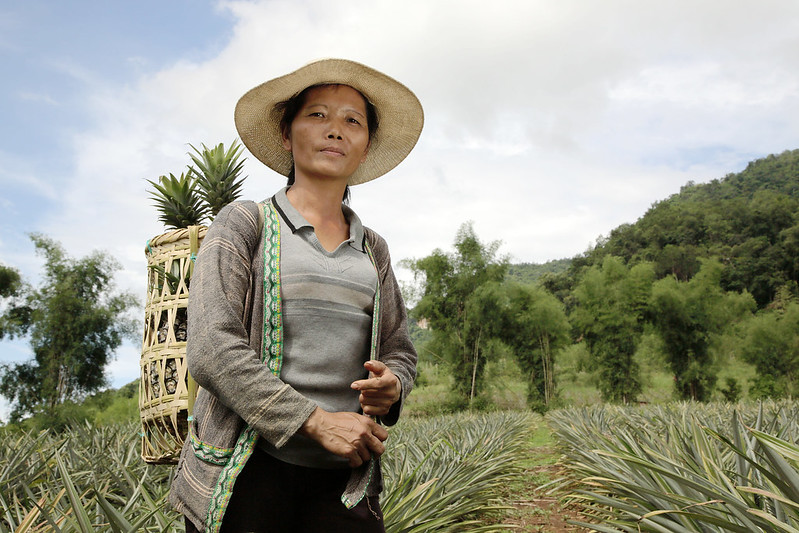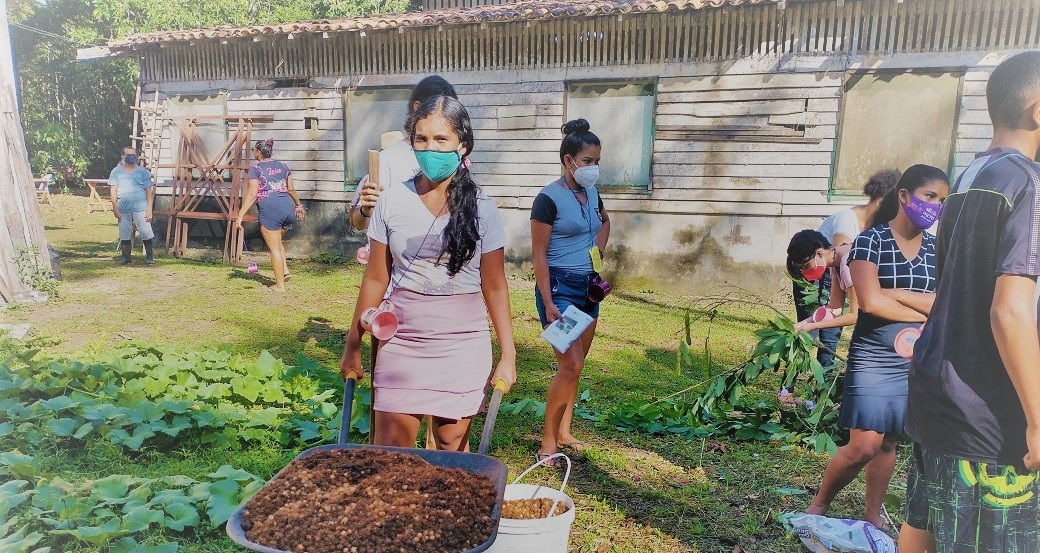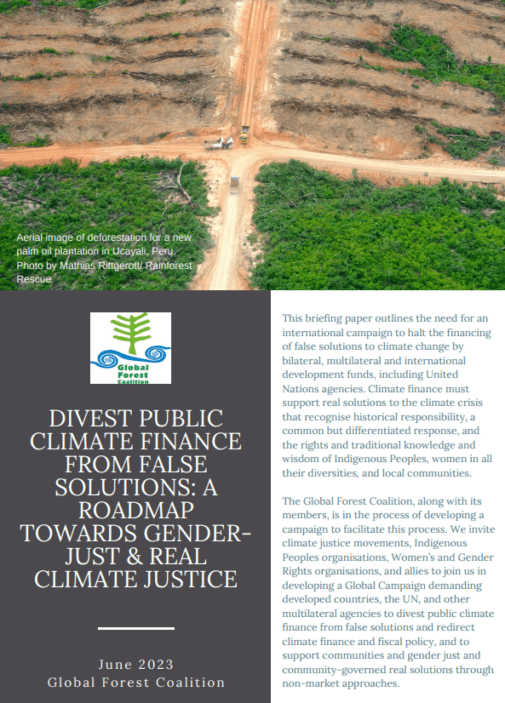El IPCC y los caminos que faltan para lograr las soluciones climáticas reales: Hacia un enfoque de modelos climáticos transformadores y basados en los derechos

Por Coraina de la Plaza y Souparna Lahiri
6 de junio de 2022
Los negociadores del cambio climático se reúnen en Bonn a partir de hoy para retomar el diálogo tras la última Conferencia de las Partes de la Convención Marco de las Naciones Unidas sobre el Cambio Climático (CMNUCC COP26) celebrada en Glasgow. Desde entonces, y mientras el mundo sigue experimentando los efectos cada vez más devastadores del cambio climático, el Grupo Intergubernamental de Expertos sobre el Cambio Climático (IPCC) ha publicado dos informes clave que muestran la grave situación en la que nos encontramos y presentan vías de adaptación y mitigación para alcanzar los objetivos de 1,5 °C y 2 °C. Se presentarán en actos especiales oficiales en Bonn. Estos informes, junto con los informes especiales sobre el calentamiento global, la tierra y los océanos y la “Base Científica Física”, convergerán en el Sexto Ciclo de Evaluación (AR6), que se presentará antes de la COP27 de la CMNUCC en Egipto. Pero a pesar de su rigor, estos informes siguen teniendo sus puntos ciegos; su excesivo enfoque en la reducción de las emisiones pasa por alto las vías de soluciones climáticas reales que sitúan la justicia y las comunidades vulnerables en el centro del análisis.
Continuar leyendo en ingles…
We believe that the IPCC reports are extremely important for understanding the various dimensions of climate change and contextualizing the many intertwined challenges that we are facing. These challenges are associated with different responses to the question of ‘ambition’ and achieving 1.5°C pathways. And while the need for climate action is urgent, understanding the context for immediate action is paramount. Climate change arises from the growing inequality that capitalism fosters and feeds on, and as the world’s wealthy continue over-consuming, grabbing diminishing resources and contributing to increasing emissions, the most vulnerable groups like indigenous peoples, women and frontline communities bear the worst impacts of this crisis.
In 2019, approximately 34% of total net anthropogenic GHG emissions came from the energy supply sector, 24% from industry, 22% from agriculture, forestry and other land use, 15% from transport and 6% from buildings. The IPCC Land Report estimates that globally, land serves as a large CO2 sink, accounting for nearly 30% of total anthropogenic emissions. There is a growing body of evidence that a large proportion of the required removals could be achieved by conserving natural sinks and building ecosystem resilience by improving biodiversity protection, and restoring ecosystem integrity is fundamental to robust climate action in land and forests and should no longer be thought of as merely a co-benefit of climate action. According to the report ‘Missing Pathways’ to 1.5°C by the Climate Land Ambition and Rights Alliance, there is the potential to restore one-quarter of the world’s natural forests and protect them along with primary forests, leading to half of global forest cover representing intact ecosystems.
Enhancing and protecting terrestrial ecosystems and natural sinks through better land governance and management and transformative agricultural practices through the stewardship of Indigenous Peoples, local communities and women in all their diversity represents a far more equitable and cost-effective way of addressing our climate crisis. But even more importantly, it is also a more just and equitable way to achieve climate mitigation targets than other carbon capture and storage measures.
Indigenous peoples’ lands account for 37% of all remaining natural lands on Earth and at least 22% of the total carbon stored in tropical and subtropical forests lies in collectively managed lands, a third of which is found in areas where indigenous peoples and local communities lack legal recognition. Securing collective and tenure rights for indigenous peoples and local communities results in lower rates of deforestation and soil degradation, and women in all their diversity are traditionally the leaders in conservation and protection of the biodiversity and ecosystem functions upon which these communities sustain themselves. Doubling the area of community-titled land, protecting and restoring degraded primary forests, natural regeneration of recently deforested areas, and responsible use of managed forests to restore biodiversity and ecosystem function would result in 6.1 Gt CO2eq per year in avoided emissions, and 8.7 Gt CO2eq per year in carbon sequestered by 2050. Amazonian indigenous territories alone store 102 Gt CO2, which is nearly one third of the Amazon region’s aboveground carbon (on roughly 30% of the land area).
Agroecological practices reflect the workings of natural ecosystems, and aspects of those ecosystems are fundamental to their functioning. There is now extensive evidence that agroecological systems are superior to high external input industrial agriculture and are highly productive and sustainable, create livelihoods, provide greater autonomy, promote climate resilience, and bring multiple social, cultural and environmental benefits.
Women in all their diversity play a key role in ecosystem conservation, natural resource management and sustainable agricultural practices such as agroecology, and they have traditional roles as knowledge keepers and conservationists. Consequently, they are also particularly impacted by forest and biodiversity loss, and ecosystem degradation overall. However, laws, cultural restrictions, patriarchy, capitalism, and social structures such as discriminatory customary laws and norms often reduce women’s capacity to support the sustainable use of land resources and have tenure over the land and natural resources. In fact, the IPCC Land Report has acknowledged the relevance of women’s land rights and participation in land governance, and the AR6 WG II report recommends a gender-responsive approach to climate policymaking to reduce climate risks and vulnerabilities. Meanwhile, the AR6 WG III finds strong evidence that empowering women benefits both mitigation and adaptation and has positive effects for climate policy.
Moreover, the strong link between securing the rights of communities and increased resilience of landscapes clearly emerges from the key findings of the Report of the Community Conservation Resilience Initiative (CCRI), a bottom-up participatory assessment we did in 68 communities from 22 countries. CCRI conclusions are that recognizing, demarcating, and protecting indigenous peoples’ territories, guaranteeing customary land and tenure rights of local communities, and promoting community autonomy and women’s leadership would greatly help the communities to maintain and improve their ability to conserve biodiversity and ecosystems and thus to address climate change mitigation and adaptation too.
However, the current IPCC modeling approaches to deep mitigation pathways for 2°C and 1.5°C are still largely based on interventions in the land sector on a massive scale, relying on, among other things, false solutions such as afforestation and reforestation, bioenergy with carbon capture and storage (BECCS) and carbon dioxide removal (CDR), technofixes to remove carbon from the atmosphere and sequester it underground that are not gender neutral. For instance, monoculture tree plantations are often used as part of afforestation and reforestation projects for bioenergy but also for other extractive industries like pulp and paper, and harassment and sexual violence affecting women in and around these plantations is one the many gender-differentiated impacts of these interventions. The framework for considering modeling pathways to 1.5°C should therefore not be so focused on emission reductions alone. Instead, the approach should be to frame models that help conserve and enhance these natural sinks, giving primacy to food sovereignty and security, and securing the rights of indigenous peoples, local communities and women to access land.
Gender-responsive and transformative rights-based approaches have so far received little attention from policy-makers, who are largely informed by modeling that is based on combustion-based economies and land sector emissions and removals. Policymakers are yet to be offered pathways that incorporate in a more comprehensive manner sociocultural and intersectoral strengthening of tenure rights and that are gender transformative and socially just – not only to address inequity, inequality, climate vulnerability, risk and resilience, or achieve SDGs simply as co-benefits of climate action, but also because there cannot be real climate action without gender, climate and social justice.
While we acknowledge that the IPCC, through its AR6 WG II Report, has finally begun to consider principles of distributive justice, procedural justice and recognition in concluding that climate justice comprises justice that links development and human rights to achieve a rights-based approach to addressing climate change, its forthcoming AR6 Synthesis Report should be bold and decisive in presenting a framework for climate mitigation that does not rely on false solutions and clearly articulates the key role of indigenous peoples and local communities and women, their tenure rights and access to land and livelihoods.
The IPCC should be instrumental in building up a global, science-based policy consensus to rapidly phase out and divest from extractive industries such as fossil fuels, halt deforestation and biodiversity loss, and address drivers like industrial agriculture and the livestock sector and put an end to offsets. A global framework is needed for real climate solutions that must be gender transformative and community governed, based on rights and socially just approaches.
About the authors: Souparna Lahiri and Coraina de la Plaza are climate campaigners at the Global Forest Coalition, a coalition of 120 NGOs and indigenous peoples’ and women’s organizations advocating for effective, rights-based forest policies.







